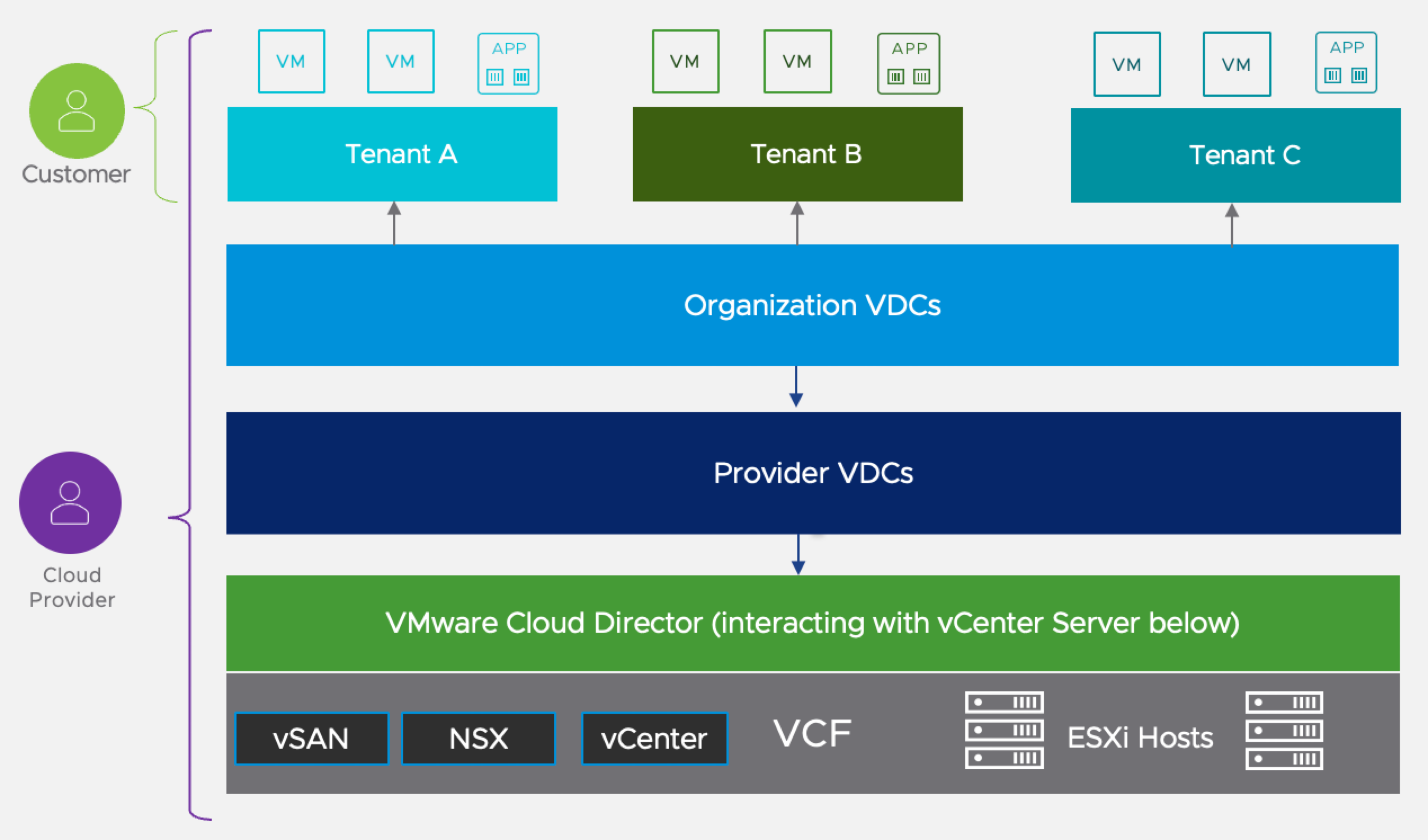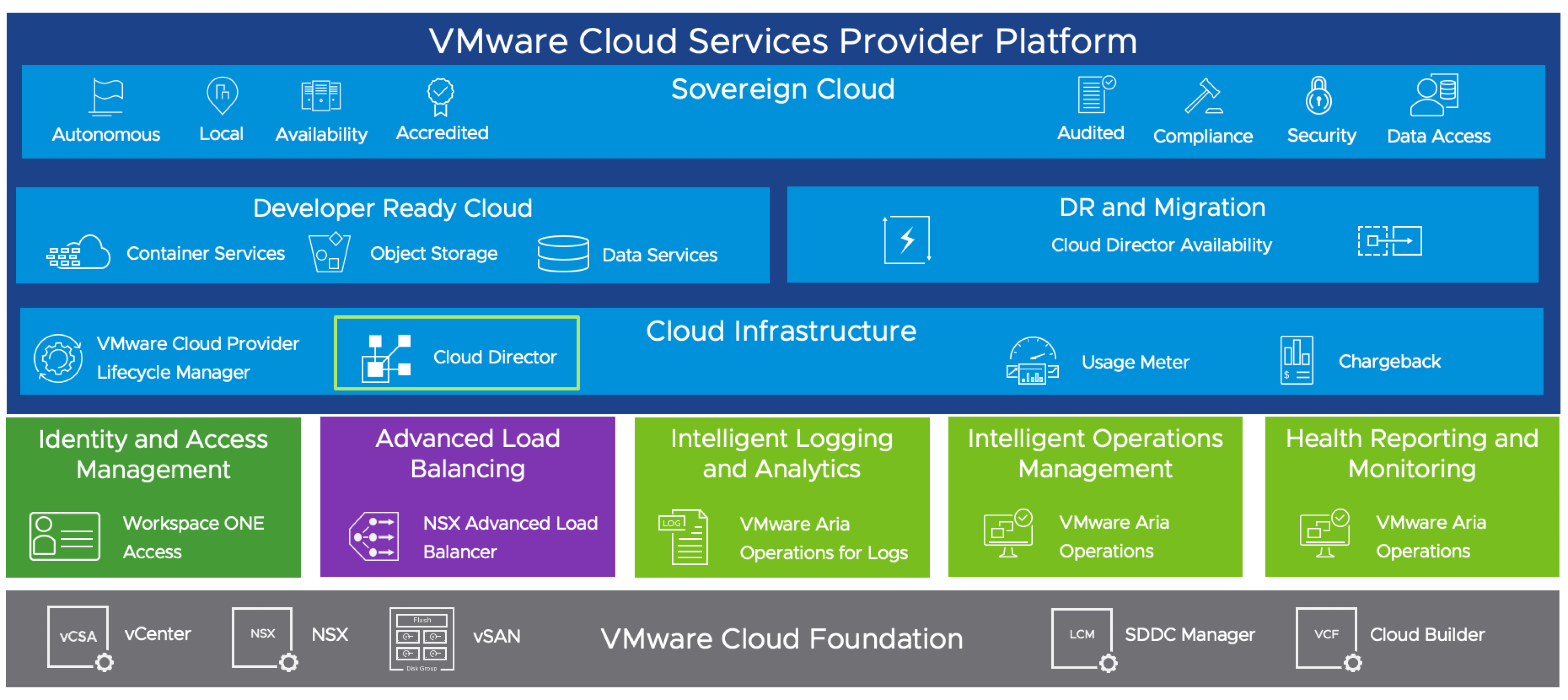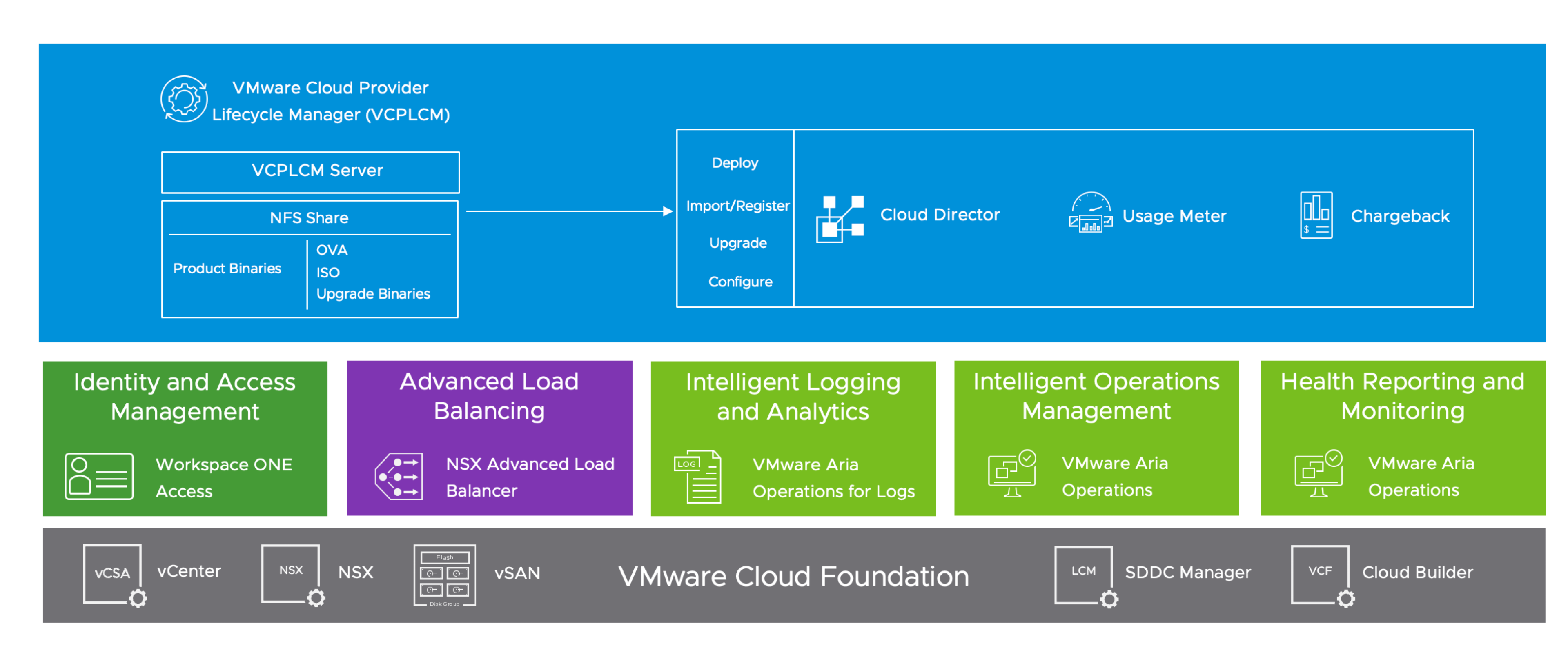Cloud Infrastructure Logical Design #
The logical design provides a high-level overview of the solution design.
VMware Cloud Provider Lifecycle Manager simplifies the operational experience by providing a comprehensive solution to deploy, upgrade, configure, and manage the VMware Cloud Provider Program products.
The Cloud Infrastucture stack is comprised of the following components:
VMware VMware Cloud Director
VMware VMware Cloud Director is VMware’s flagship cloud services platform for Cloud Providers. It is a pervasive cloud infrastructure control plane for cloud providers’ service-delivery needs, and the management entity for a global VMware cloud estate. VMware Cloud Director allows seamless provisioning and consumption of cloud computing resources and services to geographically distributed lines of business and IT teams in an API-driven approach
VMware vCloud Usage Meter
VMware vCloud Usage Meter is a virtual appliance that collects usage data VMware products that are added for metering. The collected data is sent to vCloud Usage Insight, which aggregates the data and sends it to the VMware Commerce Portal. In that portal, the aggregated usage data automatically populates each month the partner’s MBO if automatic reporting is selected.
Chargeback for VMware Cloud Director
Chargeback for VMware Cloud Director is used for metering the infrastructure services provided by a service provider to their tenants. Further, it provides options to configure different models for pricing the metered infrastructure.
RabbitMQ
RabbitMQ is an open source distributed message broker. It facilitates the efficient delivery of messages in complex routing scenarios. Initially built around the popular AMQP protocol, it’s also highly compatible with existing technologies, while its capabilities can be expanded through plug-ins enabled on the server. RabbitMQ brokers can be distributed and configured to be reliable in case of network or server failure.
Cloud Infrastructure Architecture for VMware Cloud Foundation #
Description comment
VMware VMware Cloud Director


VMware vCloud Usage Meter
UM diagram here
Chargeback for VMware Cloud Director
Chargeback diagram here
RabbitMQ
RabbitMQ diagram here
Logical Design For Product Deployment Using VMware Cloud Provider Lifecycle Manager #
The logical design provides a high-level overview of the solution design.
Deployment Architecture
Two different deployment architectures are envisioned to be supported by VVS for Cloud Providers namely Standard and Consolidated. For the standard architecture, two workload domains are considered for the VCPP deployment: VI workload domain and Private Cloud Workload Domain
The SDDC management components and workload domains will be managed by the SDDC manager.
Standard Architecture
This design is based on Standard Architecture where differemt Management and Workload Domains are used to segregate resources.
VI Workload Domain
This deployment is based on the standard VCF deployment, consisting of a management domain and at least one workload domain.
All infrastructure and cloud management components are deployed in the management domain, being physically and logically isolated from the tenant workload. Workload domains (Compute (vCenter), storage (vSAN) and network (NSX-T)) are deployed on separate hosts and configured as provider VDCs in vCloud Director.
All vCenters are running in enhanced link mode.
Private Cloud Workload Domain
This is required to support VCD’s CPOM (Central Point of Management) feature to allow direct access to dedicated vCenters. The vCenter provisioned for this domain must not have ELM enabled, as otherwise, users accessing the dedicated vCenter would be able to automatically have access to other vCenters as well.
In this architecture, each customer will get a dedicated workload domain (aka vSphere Cluster), managed by a single instance of VMware Cloud Director. The customer will consume infrastructure as a Cloud Director tenant without having vCenter server access due to ELM architecture in VCF 4.4.x release.
Consolidated Architecture
This deployment is intended for smaller environments, requiring a minimum of 4 hosts for the complete deployment. Both management and customer workloads are deployed in a single vCenter (cluster) & resources are provided using vCenter server resource pools.
VCPP Components in VMware Cloud Foundation.
For this design document, the following VCPP components must be deployed in the management domain of VMware Cloud Foundation.
Core Components:
-
VMware Cloud Director cells (VCD)
-
NFS Share for VMware Cloud Director
-
VMware Cloud Provider Lifecycle Manager
-
External NFS share for VMware Cloud Provider Lifecycle Manager
Optional products that can be deployed using VMware Cloud Provider Lifecycle Manager
-
Usage Meter (UM)
-
RabbitMQ
-
Chargeback
Most of the components will be deployed in the management domain except for tenant & development workloads.
The following diagram shows the standard architecture with VI and private cloud workload domains (consolidated architecture cannot be combined with standard architecture).

VMware Cloud Provider Lifecycle Manager Architecture #
VMware Cloud Provider Lifecycle Manager is designed as an application that provides a REST API and GUI to perform the required tasks. The underlying implementation to integrate with the corresponding products VMware Cloud Director, vRealize
Operations Manager Tenant App, RabbitMQ and Usage Meter are designed as generic product tasks.
To deploy or manage a solution, VMware Cloud Provider Lifecycle Manager requires a definition of the necessary tasks (deployment + validation, configuration, upgrade tasks) and product binaries (e.g., OVA). The REST API generic structure is applicable to different types of solutions.
VMware Cloud Provider Lifecycle Manager needs access to a repository (mounted NFS or locally) which contains OVA files, upgrade packages, etc.
The Below diagram represents the high-level architecture of VMware Cloud Provider Lifecycle Manager


Workflow Execution Process Of VMware Cloud Provider Lifecycle Manager #
Once a request is triggered by VMware Cloud Provider Lifecycle Manager’s REST API or GUI, then it will execute the corresponding task defining a list of actions. The task will be executed asynchronously. Each task will be associated with an ID which can be used to query the state of the task.
Datacenter
To enable VMware Cloud Provider Lifecycle Manager to manage products, first you must register a data center component. The data center components are instances or services available in the data center that VMware Cloud Provider Lifecycle Manager does not manage. You can register vCenter Server, NSX-T, and vRealize Operations Manager as data center components.
Environment
Products are deployed as a part of Lifecycle Manager environment. Each environment can have multiple products and user needs to provide a unique Environment ID during deployment, for identification purpose. VMware Cloud Provider doesn’t allow environments with duplicate Environment ID as it is referenced during retrieval, deletion of environment and product management operations like upgrades, node management, etc.
To deploy a product, the target vCenter to deploy in, has to be specified. This should refer to a vCenter that is registered as a datacenter component.
Product
The products follow a generic definition pattern that defines basic common product fields and requires product-specific details to be specified as properties. Each product will be associated with a unique product ID and the same will be used to retrieve the details related to the products.
Workflow Execution
The below diagram represents the product deployment process using VMware Cloud Provider Lifecyclle Manager.
